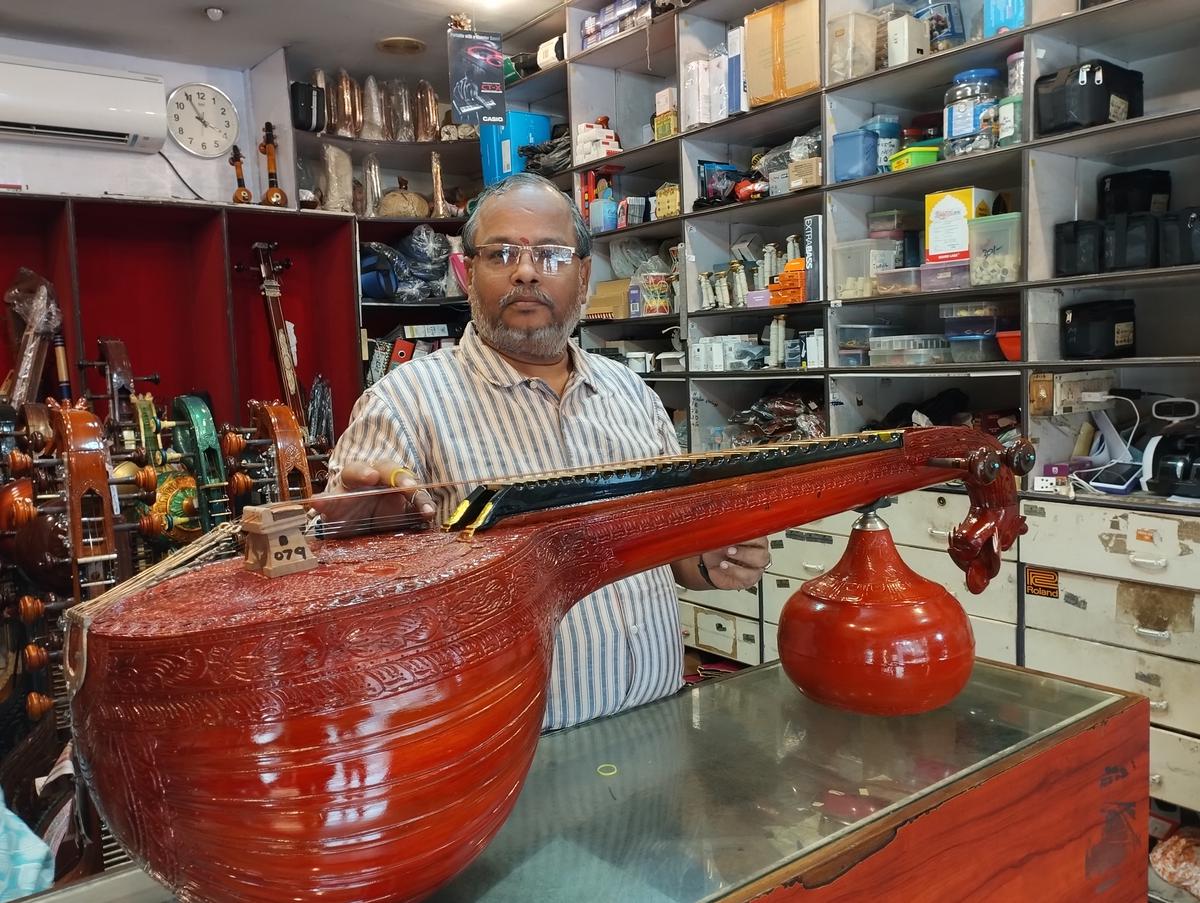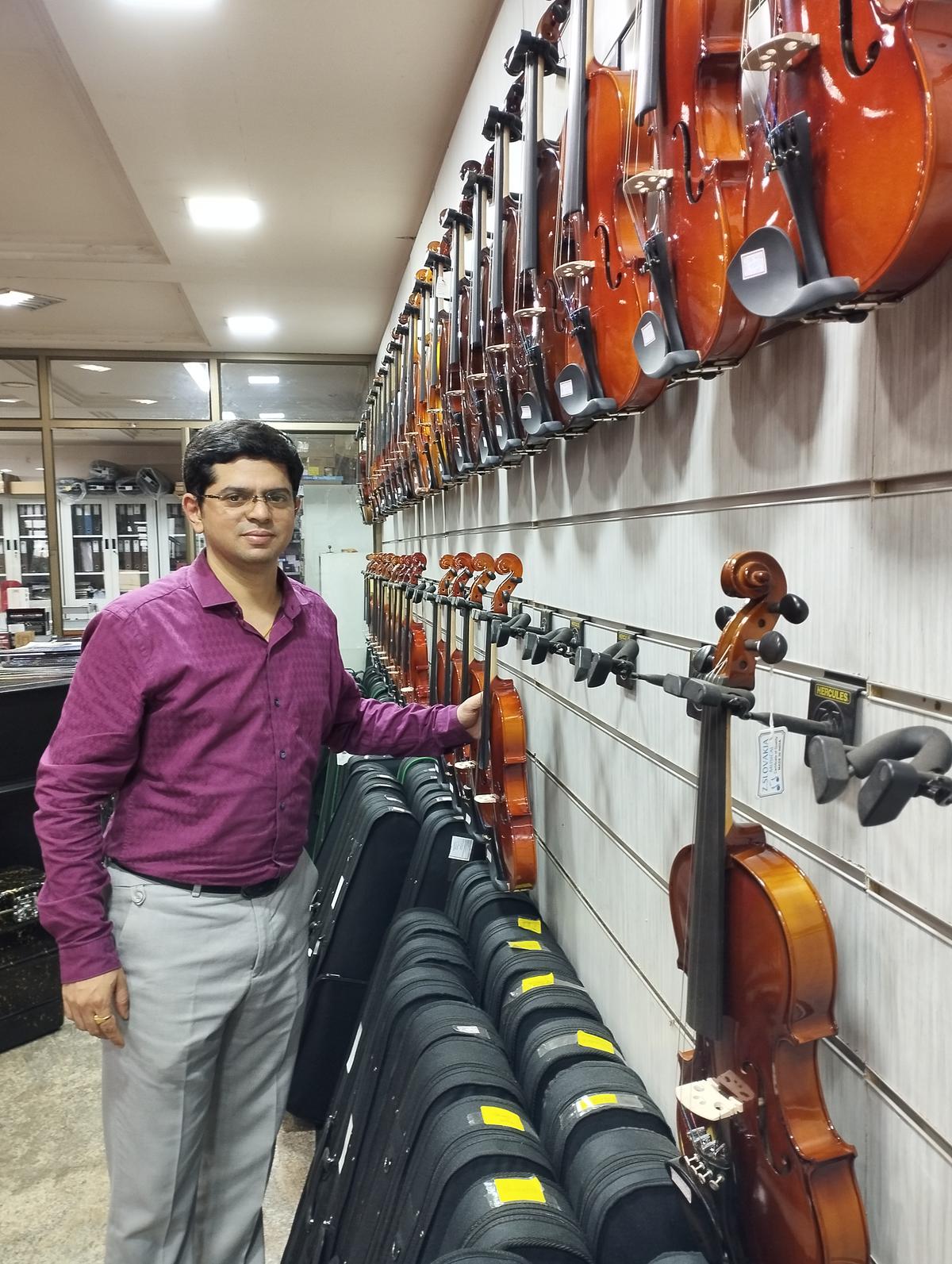Come December, and Chennai springs to life with the sound of Carnatic music. Sabhas — as performing spaces are referred to — come alive, as vocalists and instrumentalists put forth their best performances, dishing out popular and rare kritis and varnams.
It’s not just the city’s rasikas who look forward to this Margazhi season. Also waiting with bated breath are Chennai’s instrument makers. How are they gearing up for the season?
Valangaiman VAS Mridangam Makers
Navaneethakrishnan at Valangaiman VAS Mridangam Makers
| Photo Credit:
Thamodharan Bharath
The din at Warren Road in Mylapore fades inside Valangaiman VAS Mridangam Makers’ modest workshop.
Here, Navaneethakrishnan Muruganandam is busy checking the shruti (scale) on a mridangam he has made.
He has been in the profession of making and maintaining instruments since the ‘90s, continuing his father Muruganandam’s legacy. Along with his brother, he has made hundreds of mridangams, all used by leading percussionists in the city today. This December, he is busier as last-minute season orders and repair work fill his day. “And it rains this time of the year, which is a bad thing if you’re in this business. We need the sun because this work involves a lot of drying; it takes around a week to complete work on a mridangam if the sun is out,” he says.
The process of making a mridangam is rather elaborate. The wood is procured from Panruti in Tamil Nadu, and then Navaneethakrishnan and his brother, Sudhakar, get to work. “A lot of the work is done by hand. For the sound to be perfect, we have to add layers of cow hide, goat hide and buffalo hide. We usually have a conversation with the person who places an order because the shruti (scale) changes from person to person,” he says.
Priced at about ₹24,000 a piece, Valangaiman VAS’ clientele includes leading percussionists like Tiruvarur Bhaktavatsalam, Trichy Sankaran, Delhi Sairam, AS Ranganathan and Sumesh Narayanan, among others.
Thanks to technological developments, newer, snazzier versions of the mridangam have emerged, but Navaneethakrishnan is not perturbed and still roots for the traditional way of making the instrument. “That sound is still unmatched.”
The Sruthilaya

R Lakshmanagoswami of The Sruthilaya
Yuko Matoba from Japan makes an annual visit to Chennai during the music season. A veena teacher and performer, she heads to all the leading sabhas of the city, and also makes it a point to stop at The Sruthilaya, an instrument shop on Royapettah High Road.
“We’re WhatsApp friends now,” smiles R Lakshmanagoswami, who runs the shop.
The origin of this unlikely friendship dates back a few years, when Yuko ventured into his shop enquiring about a ‘special melam veena’ that she wanted to take back to her country. This is a veena that Lakshmanagoswami conceptualised a decade ago, after trying out several permutations and combinations in the traditional instrument structure, and tailor-making it to the needs of the constant traveller and changing climatic conditions across the globe. “A veena is like a train track. If exposed to extreme heat or cold, it can come off like a train track. Also, if even one of the many kattai (blocks) attached to it comes off, the sound of the music can be off and a performer will not be able to play properly,” says Lakshmanagoswami.
Starting off at a price point of ₹50,000, Lakshmanagoswami’s ‘special melam veena’ is among the hotsellers in his store, which has been operating from this location since 2000. He has been in the business since 1989, when he started off with an outlet in Thanjavur.
Being a trained flautist himself and possessing the ability to play basic songs on the veena, Lakshmanagoswami spoke in a language that performers understood, thus drawing many performers, especially from overseas, to his outlet. “In the US, in Sri Lanka and in many countries abroad, Indian culture – and the many instruments associated with Carnatic music – is valued richly. We see an increase in sales during the season because a lot of foreigners visit the city for the music season and like to take back home an Indian instrument,” he says, adding that he also stocks the joint veena (an assembled version) and ekantha veena (made of a single piece of jackfruit wood).
The flute and violin are also in demand during this time of the year, as are shruti boxes, which help vocalists sing to a scale that suits their voice range. But the veena remains the most close to his heart. “I’m currently designing a new veena that is smaller in length, thus making it easier for travellers to take abroad. For this, I plan to use a CNC (computer numerical control) machine that will cut making and labour cost.”
He is trying to do this without compromising on the traditional features associated with the instrument. He says that the naadam, as the musical sound is referred to, is most important. “At the end of the day, it should sound nice, whether you play it in your hall at home, or in a sabha.”
Chandru Musicals
R Chandrasekar of Chandru Musicals
| Photo Credit:
S Shiva Raj
The guitar and the veena, which hail from different musical backgrounds, share the stage and not just at fusion concerts. They are placed right next to each other at Chandru Musicals, located inside one of the many dusty, bumpy roads at Puzhuthivakkam, less than five kilometres from Chennai airport.
R Chandrasekar, who runs it, hails from a family that has been in the business for many generations; his great grandfather made harmoniums and veenas for a living in Thanjavur, passing on the legacy to his son, who arrived in Chennai in the 1900s to cater to the then-burgeoning music industry. He still has a Thanjavur connection; the wood and body of the veena come from there to Chandrasekar’s residence-cum-shop. Here, it undergoes transformation, adorned with strings, blocks and artwork, thus resulting in a kutcheri-friendly veena. “On one occasion, a customer from abroad heard a veena performance and wanted the same instrument immediately as he was travelling abroad soon. We made an ekantha veena, with artwork decoration, in record time,” beams Chandrasekar, who is hopeful of more patronage for Indian instruments in the future.
Saptaswara Musicals

Nikhil Natwarlal at Saptaswara Musicals
“Hello, can I just look around,” someone asks Nikhil Natwarlal, who nods with a smile.
Nikhil gets such requests often at Saptaswara Musicals, his swanky air-conditioned musical instruments showroom, located opposite the famous Luz Anjaneyar temple. During the December music season, these requests only increase in number and at most times, result in a sale.
“There is a 20% increase in sales during this particular month. A lot of NRIs visiting India during their Christmas-New Year holidays end up purchasing an Indian instrument,” says Nikhil.
Saptaswara Musicals, launched in 1979, is well known among the city’s music community for not just the purchase of new instruments but also repair and maintenance. Their in-house technicians set the bridge of the violin right and replenish the wax in the veena, among other services. Their patrons include popular Carnatic vocalists Sanjay Subrahmanyan, Aruna Sairam, Geetha Raja and violinists Lalgudi Krishnan and Cello Sekar, among others.
While the keyboard and guitar sell through the year, it is the violin, veena, flute and mridangam that are in demand during the season, adds Nikhil. “It is seen as a sign of Indian culture. While people in India are playing the keyboard and guitar, people from abroad seem to be interested in picking up Indian classical instruments.”
https://www.thehindu.com/entertainment/music/how-chennais-instrument-makers-gear-up-for-the-margazhi-music-season/article67629995.ece”>
#Chennais #instrument #makers #gear #Margazhi #music #season
